Financial Management Report: Xiaojing Wu's Business Options Analysis
VerifiedAdded on 2023/01/20
|6
|980
|96
Report
AI Summary
This report analyzes the business case of Xiaojing Wu, an entrepreneur from China, who immigrated to Australia to establish a business in South Australia. The report examines two primary options for Xiaojing: setting up a small proprietary company or listing the company on the Australian Stock Exchange (ASX). The discussion covers the advantages and disadvantages of proprietary companies compared to partnerships, including liability, regulatory burdens, and taxation. It also explores the steps involved in setting up a small proprietary business, outlining the rights and obligations of company directors and the available funding options. The second part of the report compares listed companies to small private companies, focusing on capital-raising capabilities, regulatory requirements, and disclosure obligations. The report details the funding options available to ASX-listed companies and outlines the reporting requirements of the Australian Securities Exchange. The conclusion summarizes the merits and demerits of both options, providing Xiaojing Wu with a comprehensive understanding to make an informed decision about her company's structure.
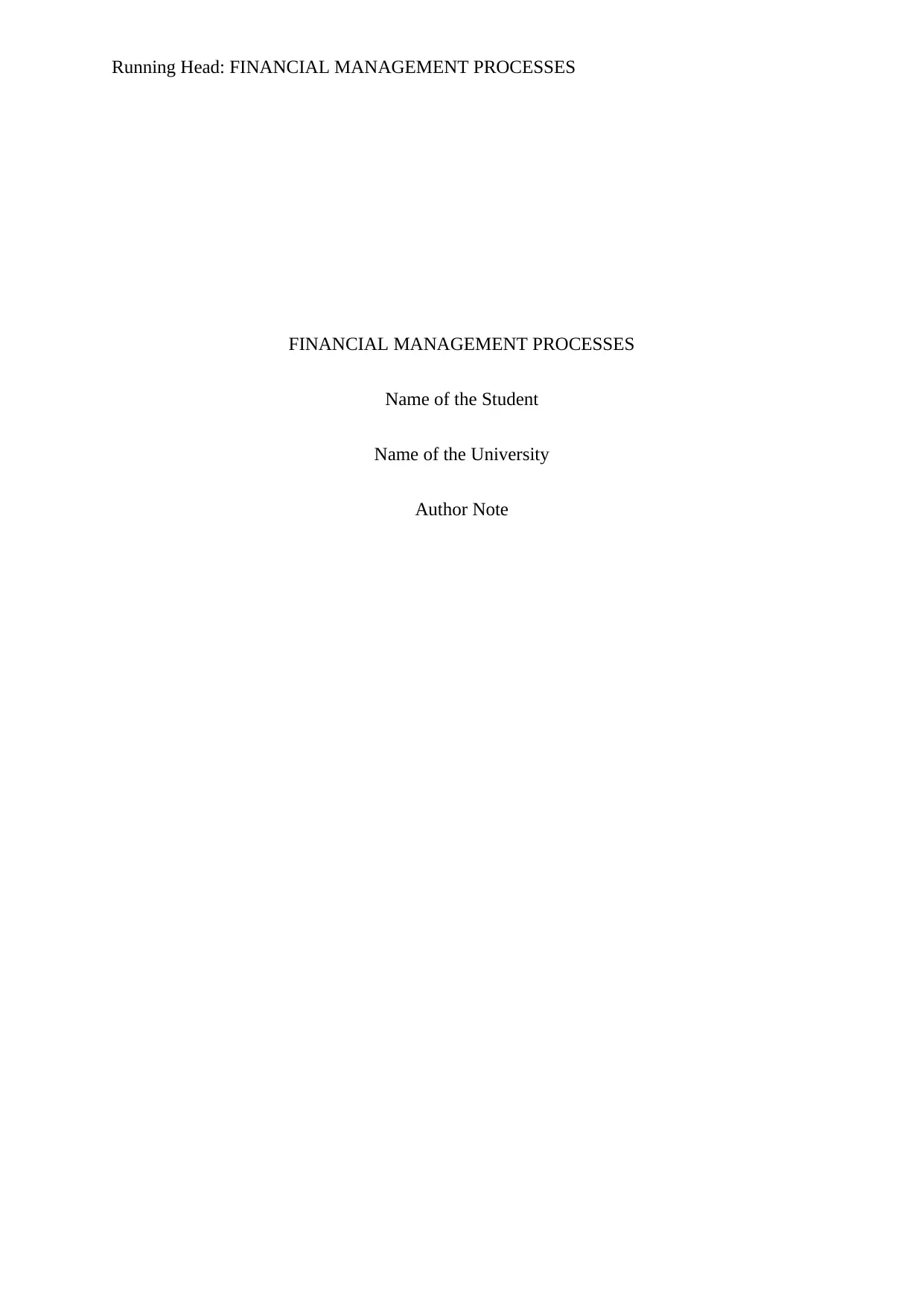
Running Head: FINANCIAL MANAGEMENT PROCESSES
FINANCIAL MANAGEMENT PROCESSES
Name of the Student
Name of the University
Author Note
FINANCIAL MANAGEMENT PROCESSES
Name of the Student
Name of the University
Author Note
Paraphrase This Document
Need a fresh take? Get an instant paraphrase of this document with our AI Paraphraser
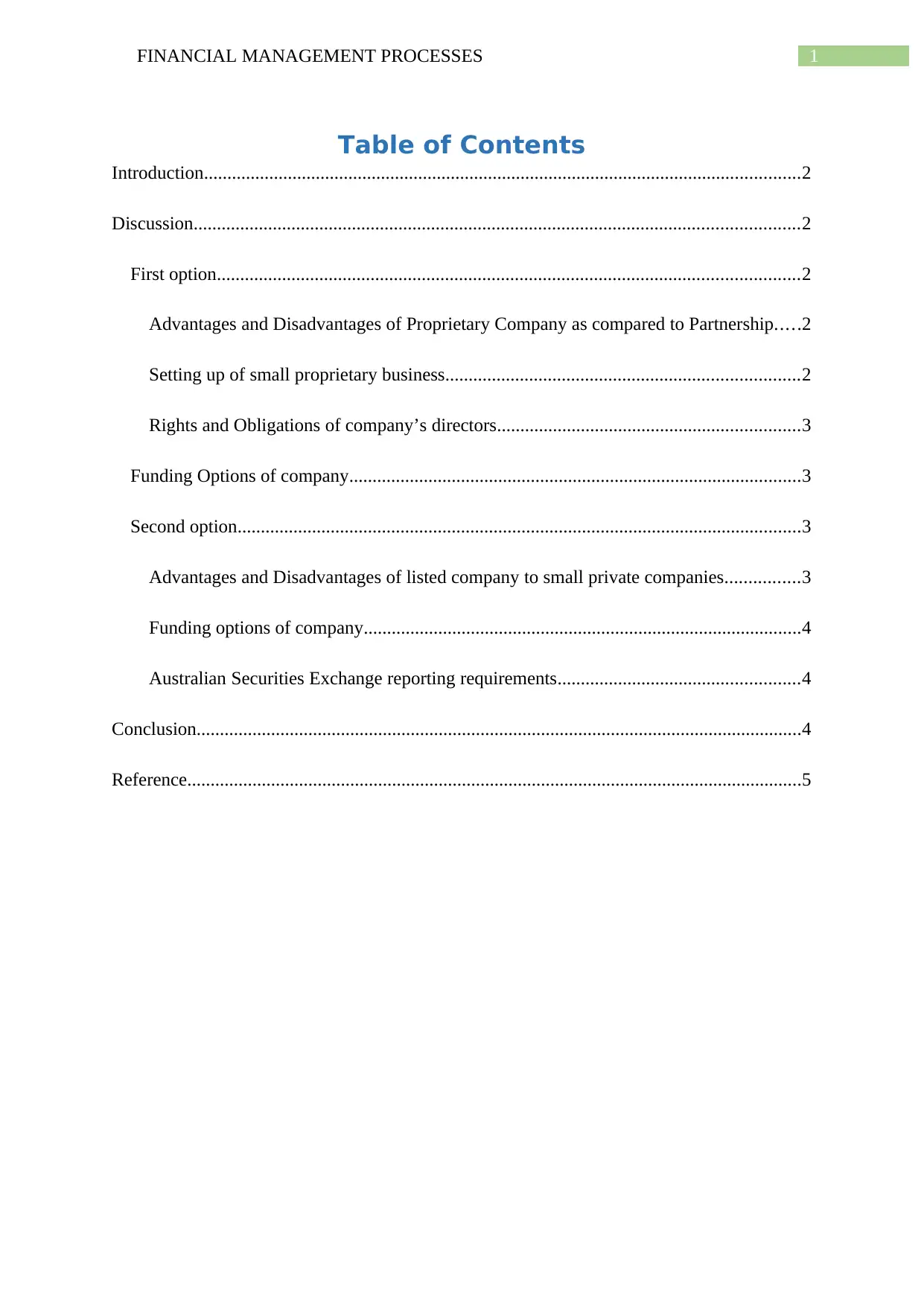
1FINANCIAL MANAGEMENT PROCESSES
Table of Contents
Introduction................................................................................................................................2
Discussion..................................................................................................................................2
First option.............................................................................................................................2
Advantages and Disadvantages of Proprietary Company as compared to Partnership.....2
Setting up of small proprietary business............................................................................2
Rights and Obligations of company’s directors.................................................................3
Funding Options of company.................................................................................................3
Second option.........................................................................................................................3
Advantages and Disadvantages of listed company to small private companies................3
Funding options of company..............................................................................................4
Australian Securities Exchange reporting requirements....................................................4
Conclusion..................................................................................................................................4
Reference....................................................................................................................................5
Table of Contents
Introduction................................................................................................................................2
Discussion..................................................................................................................................2
First option.............................................................................................................................2
Advantages and Disadvantages of Proprietary Company as compared to Partnership.....2
Setting up of small proprietary business............................................................................2
Rights and Obligations of company’s directors.................................................................3
Funding Options of company.................................................................................................3
Second option.........................................................................................................................3
Advantages and Disadvantages of listed company to small private companies................3
Funding options of company..............................................................................................4
Australian Securities Exchange reporting requirements....................................................4
Conclusion..................................................................................................................................4
Reference....................................................................................................................................5
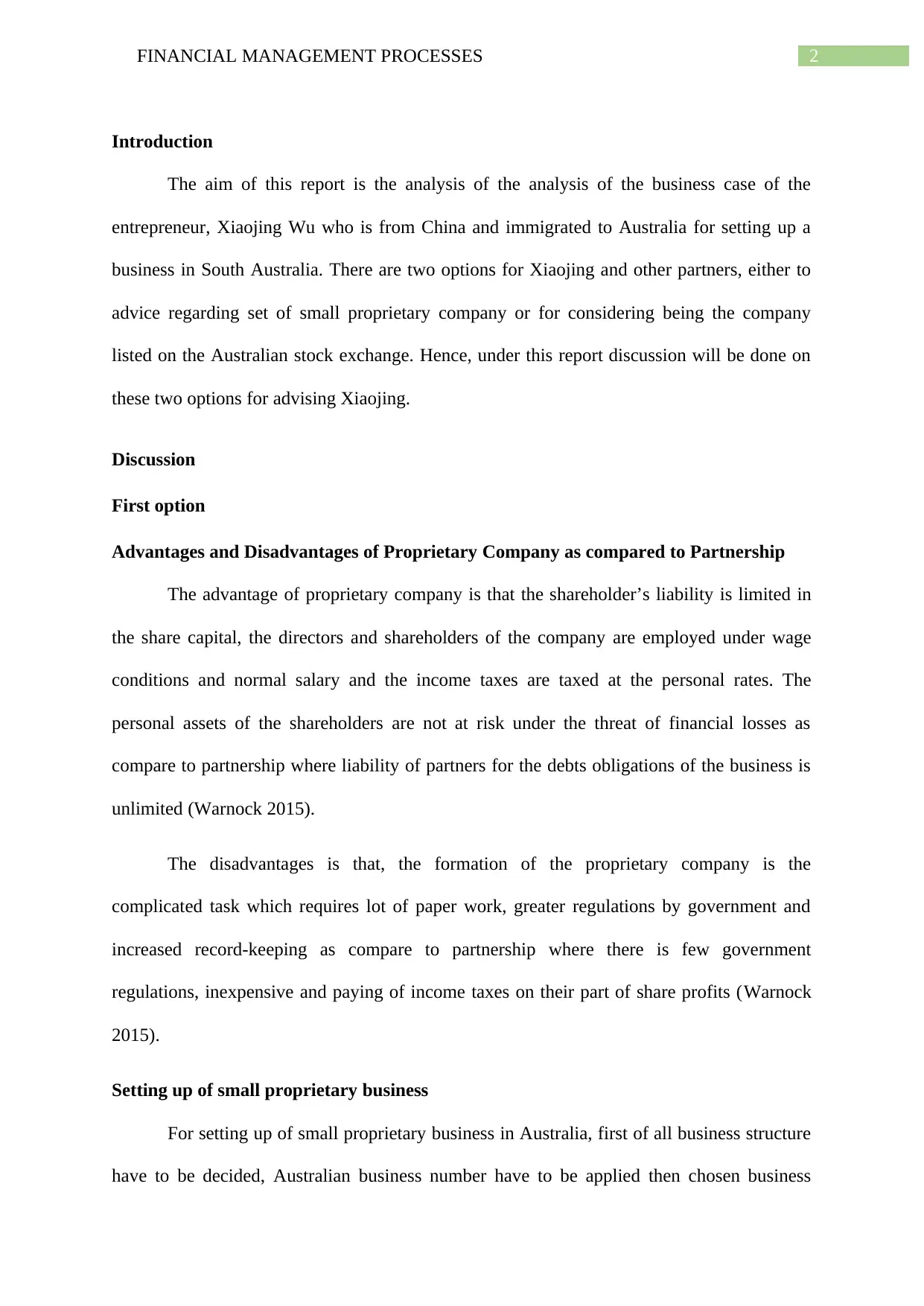
2FINANCIAL MANAGEMENT PROCESSES
Introduction
The aim of this report is the analysis of the analysis of the business case of the
entrepreneur, Xiaojing Wu who is from China and immigrated to Australia for setting up a
business in South Australia. There are two options for Xiaojing and other partners, either to
advice regarding set of small proprietary company or for considering being the company
listed on the Australian stock exchange. Hence, under this report discussion will be done on
these two options for advising Xiaojing.
Discussion
First option
Advantages and Disadvantages of Proprietary Company as compared to Partnership
The advantage of proprietary company is that the shareholder’s liability is limited in
the share capital, the directors and shareholders of the company are employed under wage
conditions and normal salary and the income taxes are taxed at the personal rates. The
personal assets of the shareholders are not at risk under the threat of financial losses as
compare to partnership where liability of partners for the debts obligations of the business is
unlimited (Warnock 2015).
The disadvantages is that, the formation of the proprietary company is the
complicated task which requires lot of paper work, greater regulations by government and
increased record-keeping as compare to partnership where there is few government
regulations, inexpensive and paying of income taxes on their part of share profits (Warnock
2015).
Setting up of small proprietary business
For setting up of small proprietary business in Australia, first of all business structure
have to be decided, Australian business number have to be applied then chosen business
Introduction
The aim of this report is the analysis of the analysis of the business case of the
entrepreneur, Xiaojing Wu who is from China and immigrated to Australia for setting up a
business in South Australia. There are two options for Xiaojing and other partners, either to
advice regarding set of small proprietary company or for considering being the company
listed on the Australian stock exchange. Hence, under this report discussion will be done on
these two options for advising Xiaojing.
Discussion
First option
Advantages and Disadvantages of Proprietary Company as compared to Partnership
The advantage of proprietary company is that the shareholder’s liability is limited in
the share capital, the directors and shareholders of the company are employed under wage
conditions and normal salary and the income taxes are taxed at the personal rates. The
personal assets of the shareholders are not at risk under the threat of financial losses as
compare to partnership where liability of partners for the debts obligations of the business is
unlimited (Warnock 2015).
The disadvantages is that, the formation of the proprietary company is the
complicated task which requires lot of paper work, greater regulations by government and
increased record-keeping as compare to partnership where there is few government
regulations, inexpensive and paying of income taxes on their part of share profits (Warnock
2015).
Setting up of small proprietary business
For setting up of small proprietary business in Australia, first of all business structure
have to be decided, Australian business number have to be applied then chosen business
⊘ This is a preview!⊘
Do you want full access?
Subscribe today to unlock all pages.

Trusted by 1+ million students worldwide
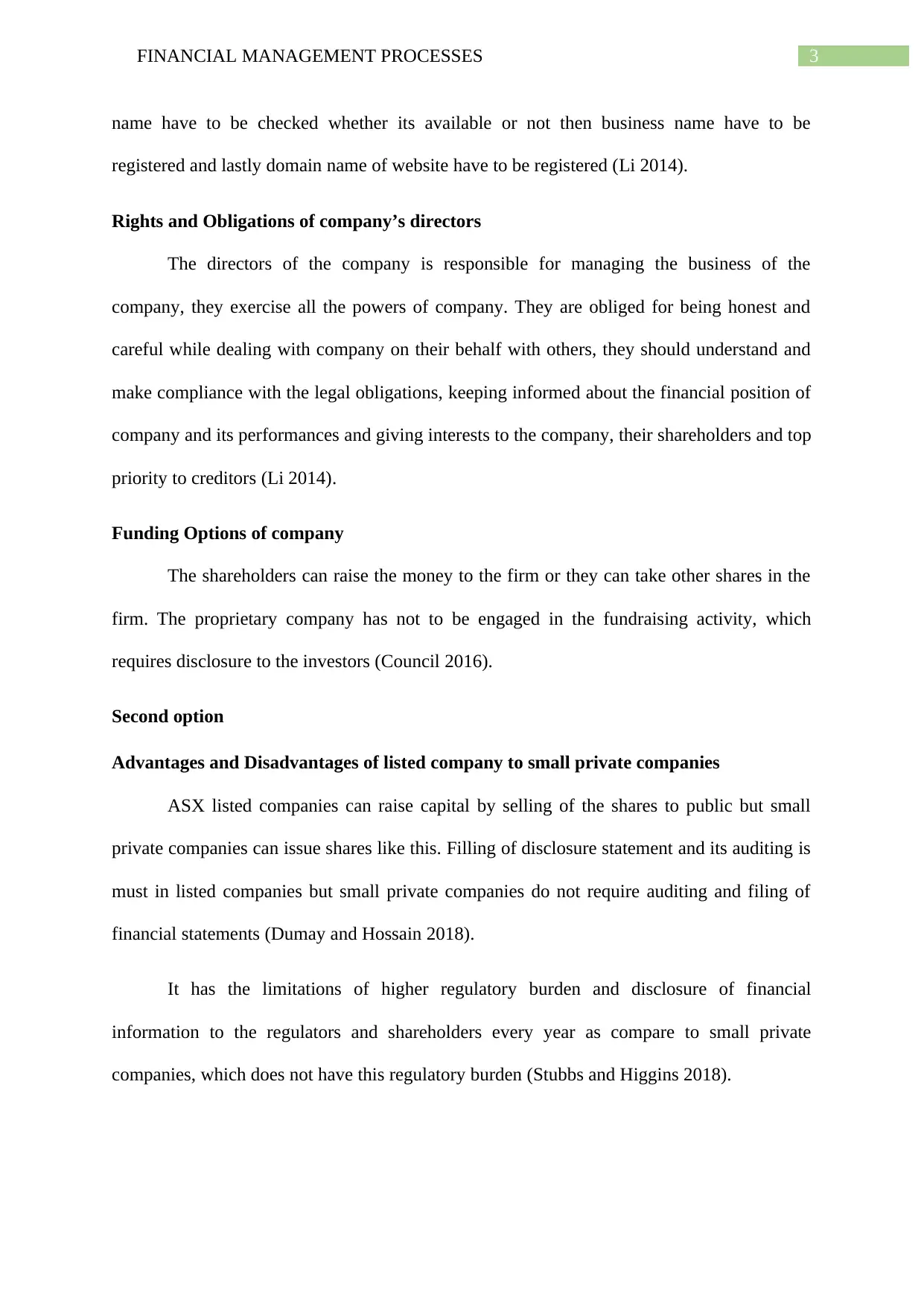
3FINANCIAL MANAGEMENT PROCESSES
name have to be checked whether its available or not then business name have to be
registered and lastly domain name of website have to be registered (Li 2014).
Rights and Obligations of company’s directors
The directors of the company is responsible for managing the business of the
company, they exercise all the powers of company. They are obliged for being honest and
careful while dealing with company on their behalf with others, they should understand and
make compliance with the legal obligations, keeping informed about the financial position of
company and its performances and giving interests to the company, their shareholders and top
priority to creditors (Li 2014).
Funding Options of company
The shareholders can raise the money to the firm or they can take other shares in the
firm. The proprietary company has not to be engaged in the fundraising activity, which
requires disclosure to the investors (Council 2016).
Second option
Advantages and Disadvantages of listed company to small private companies
ASX listed companies can raise capital by selling of the shares to public but small
private companies can issue shares like this. Filling of disclosure statement and its auditing is
must in listed companies but small private companies do not require auditing and filing of
financial statements (Dumay and Hossain 2018).
It has the limitations of higher regulatory burden and disclosure of financial
information to the regulators and shareholders every year as compare to small private
companies, which does not have this regulatory burden (Stubbs and Higgins 2018).
name have to be checked whether its available or not then business name have to be
registered and lastly domain name of website have to be registered (Li 2014).
Rights and Obligations of company’s directors
The directors of the company is responsible for managing the business of the
company, they exercise all the powers of company. They are obliged for being honest and
careful while dealing with company on their behalf with others, they should understand and
make compliance with the legal obligations, keeping informed about the financial position of
company and its performances and giving interests to the company, their shareholders and top
priority to creditors (Li 2014).
Funding Options of company
The shareholders can raise the money to the firm or they can take other shares in the
firm. The proprietary company has not to be engaged in the fundraising activity, which
requires disclosure to the investors (Council 2016).
Second option
Advantages and Disadvantages of listed company to small private companies
ASX listed companies can raise capital by selling of the shares to public but small
private companies can issue shares like this. Filling of disclosure statement and its auditing is
must in listed companies but small private companies do not require auditing and filing of
financial statements (Dumay and Hossain 2018).
It has the limitations of higher regulatory burden and disclosure of financial
information to the regulators and shareholders every year as compare to small private
companies, which does not have this regulatory burden (Stubbs and Higgins 2018).
Paraphrase This Document
Need a fresh take? Get an instant paraphrase of this document with our AI Paraphraser

4FINANCIAL MANAGEMENT PROCESSES
Funding options of company
ASX listed company raise the fund by two options, they borrow the funds from other
financial institution or they can raise more equity.
Australian Securities Exchange reporting requirements
The companies which are listed o ASX are bound to rules of periodic and continuous
disclosures in relation to financial statements, immediate notice of material information,
notice to the specific information, new issue information, announcement of buyback and so
on (Stubbs et al. 2014).
Conclusion
Hence, it is concluded from the analysis of the two issues that both the issues have
their merits and demerits. Further, discussion has been done on the advantages,
disadvantages, funding options and reporting requirements of all types of companies.
Therefore, Xiaojing Wu has to decide which option she will pick for forming a company.
Funding options of company
ASX listed company raise the fund by two options, they borrow the funds from other
financial institution or they can raise more equity.
Australian Securities Exchange reporting requirements
The companies which are listed o ASX are bound to rules of periodic and continuous
disclosures in relation to financial statements, immediate notice of material information,
notice to the specific information, new issue information, announcement of buyback and so
on (Stubbs et al. 2014).
Conclusion
Hence, it is concluded from the analysis of the two issues that both the issues have
their merits and demerits. Further, discussion has been done on the advantages,
disadvantages, funding options and reporting requirements of all types of companies.
Therefore, Xiaojing Wu has to decide which option she will pick for forming a company.
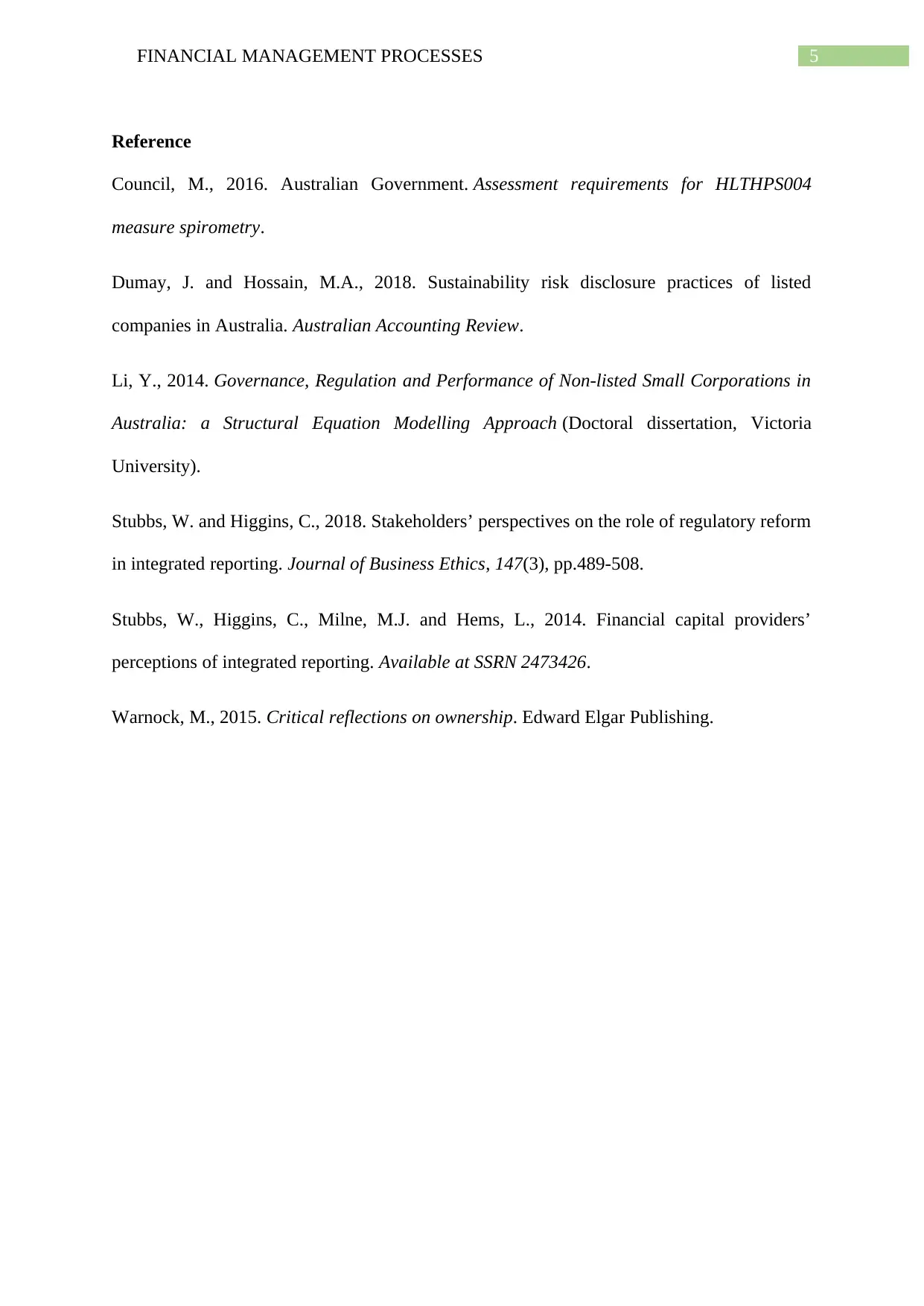
5FINANCIAL MANAGEMENT PROCESSES
Reference
Council, M., 2016. Australian Government. Assessment requirements for HLTHPS004
measure spirometry.
Dumay, J. and Hossain, M.A., 2018. Sustainability risk disclosure practices of listed
companies in Australia. Australian Accounting Review.
Li, Y., 2014. Governance, Regulation and Performance of Non-listed Small Corporations in
Australia: a Structural Equation Modelling Approach (Doctoral dissertation, Victoria
University).
Stubbs, W. and Higgins, C., 2018. Stakeholders’ perspectives on the role of regulatory reform
in integrated reporting. Journal of Business Ethics, 147(3), pp.489-508.
Stubbs, W., Higgins, C., Milne, M.J. and Hems, L., 2014. Financial capital providers’
perceptions of integrated reporting. Available at SSRN 2473426.
Warnock, M., 2015. Critical reflections on ownership. Edward Elgar Publishing.
Reference
Council, M., 2016. Australian Government. Assessment requirements for HLTHPS004
measure spirometry.
Dumay, J. and Hossain, M.A., 2018. Sustainability risk disclosure practices of listed
companies in Australia. Australian Accounting Review.
Li, Y., 2014. Governance, Regulation and Performance of Non-listed Small Corporations in
Australia: a Structural Equation Modelling Approach (Doctoral dissertation, Victoria
University).
Stubbs, W. and Higgins, C., 2018. Stakeholders’ perspectives on the role of regulatory reform
in integrated reporting. Journal of Business Ethics, 147(3), pp.489-508.
Stubbs, W., Higgins, C., Milne, M.J. and Hems, L., 2014. Financial capital providers’
perceptions of integrated reporting. Available at SSRN 2473426.
Warnock, M., 2015. Critical reflections on ownership. Edward Elgar Publishing.
⊘ This is a preview!⊘
Do you want full access?
Subscribe today to unlock all pages.

Trusted by 1+ million students worldwide
1 out of 6
Related Documents
Your All-in-One AI-Powered Toolkit for Academic Success.
+13062052269
info@desklib.com
Available 24*7 on WhatsApp / Email
![[object Object]](/_next/static/media/star-bottom.7253800d.svg)
Unlock your academic potential
Copyright © 2020–2025 A2Z Services. All Rights Reserved. Developed and managed by ZUCOL.




